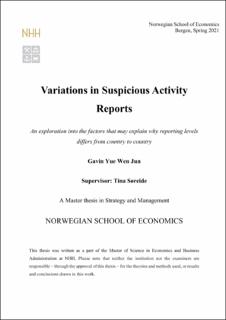Variations in suspicious activity reports : an exploration into the factors that may explain why reporting levels
Master thesis
Permanent lenke
https://hdl.handle.net/11250/2767126Utgivelsesdato
2021Metadata
Vis full innførselSamlinger
- Master Thesis [4378]
Sammendrag
The risk-based approach (RBA) was initially introduced in 2013 by the Financial Action Task
Force (FATF) as a solution to the increasing volumes of suspicious activity reports (SARs)
filed by regulated entities and the subsequent workload on enforcement authorities. However,
since then, suspicious reports have not shown a dramatic decrease in volume but has in fact
been increasing, suggesting a potential relationship between the two. One of the main reasons
surround the uncertainty and ambiguity that both regulators and regulated entities face when
interpreting what constitutes low, medium or high risk when it comes to assessing risk in their
own context. This is highlighted from AML activities such as identification of politically
exposed persons and beneficial owners as well as the risk categorization of countries. To
investigate this potential relationship, a regression analysis is performed using SAR data on
compliance scores from the 4th round of Mutual Evaluation Reports (MERs). Mutual
evaluations are a process for FATF to understand how well a country is performing on each
of their 40 recommendations (FATF, 2021) thus the scores from these reports act as an
indicator for how closely a country follows the RBA recommendation from FATF. The results
indicate that there is a significant and positive relationship between the two variables.
Countries that achieve higher scores, which indicate that they follow the RBA closely (in large
part due to potential fines and exclusion from the global financial system), file more SARs.
Because some institutions may choose not to follow this approach so closely, variations across
countries occur. This suggests that the description of the RBA is too broad and ambiguous,
leaving each country’s regulators and regulated entities uncertain as to what constitutes low
or high-risk activity. To hedge against this uncertainty and err on the side of caution, regulated
entities rather choose to report transactions on the border of being suspicious, contributing to
a problem known as defensive reporting, leading to a further increase in SAR volumes. When
SAR volumes are too high, each subsequent report loses credibility thus diminishing the value
that the SAR regime can provide, what is termed the phenomenon of the ‘Crying Wolf’. The
outcome of this analysis provides a starting point towards the conversation that indeed, the
risk-based approach does contribute to increased SAR levels and variation across countries.
Consequently, the risk-based approach can be further refined to reduce uncertainty that
governments, regulators and regulated entities face. Hopefully, by doing so, the value of
reporting suspicious activity is preserved and allows SAR levels to be used as a meaningful
indicator of the effectiveness of AML regimes.
